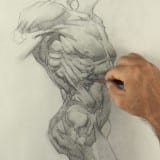Illustrator & Concept Artist Learning Path
Something to keep in mind…
These learning paths outline different “years” of training. The general breakdown assumes that a student can complete a phase in about one month. Keep in mind that this is the optimal state of progression, and that many of us who already have a day job or other responsibilities may have a difficult time keeping this pace up. These learning paths are a general outline for our curriculum, so apply it to your own life, goals and allotted time for art.
First Year
The first year of your training at Watts Atelier will consist of foundational drawing. A heavy emphasis will be placed on constructive drawing, comparative measurement and use of the Reilly abstraction.
The idea for the first year is to be doing a lot of “starts” of drawings. We will not be getting into finishing drawings in the first year, though you will practice some rendered/shaded efforts.
Check the Course Previews Page to see a video description on each class.
Course list, from left to right:
-
- Drawing Fundamentals Phase I
- Drawing Fundamentals Phase II
- Head Drawing Fundamentals
- Figure Drawing Fundamentals
- Quicksketch Fundamentals
- Structural Figure Drawing
- Head Phase I – Layins and Structure
- Figure Phase I – Mannequinization
- Head Phase II – Casts and Photos
- Figure Phase II – 20m Layins
- Head Phase III
- Figure Phase III – Figure Quicksketch (Coming 2024)
Second Year
The second year will focus on introducing you to painting. Starting with basic Gouache and oil painting in the monochrome and Zorn palette. The second year will also introduce you into more complex and finessed drawing with a focus on good proportions, values and edgework. As you move into the later section of this year you’ll be working more on master studies and gestures.












Check the Course Previews Page to see a video description on each class.
Course list, from left to right:
- Gouache Phase I
- Gouache Phase II
- Head Drawing Phase IV
- Figure Drawing Phase IV
- Oil Painting Fundamentals
- Portrait Phase I
- Gouache Phase III
- Figure Painting Phase I
- Portrait Phase II
- Figure Painting Phase II
- Landscape Phase I
- Still Life Phase I
Third Year
The third year will start to uncover advanced learning. As you continue to progress, you will hit higher levels of still life, landscape, portrait and figure. You will also start to touch upon some of the more fundamental master classes at this stage such as drapery, perspective and anatomy intensives.














Check the Course Previews Page to see a video description on each class.
Course list, from left to right:
- Landscape Painting Phase II
- Portrait Painting Phase III
- Still Life Painting Phase II
- Head Drawing Phase V
- Figure Painting Phase III
- Figure Drawing Phase V
- Landscape Painting Phase III
- Still Life Painting Phase III
- Portrait Phase IV
- Drapery
- Perspective Essentials
- Anatomy Intensives: Arms and Legs
- Anatomy Intensives: Torso
- Figure Painting Phase IV
Going Forward
In the fourth year and going forward you will start to uncover advanced learning. You can and should tackle these classes in ANY ORDER that you prefer. Follow your passions and interest. At this point your portfolio development should become your priority. Always keep going back a few times a week and work on your fundamentals: Portrait, Figure, Landscape and Still Life. This consistent and regular practice will help you stay on point. As Jeff says, those fundamentals and continuous practice is like an athlete going to the gym to stay in shape. You want your visual/artistic acumen to stay in top shape!













Check the Course Previews Page to see a video description on each class.
Course list, from left to right:
- Observational Color
- Features and Facial Expressions
- Bridgman Anatomy Phase I: Torso
- Fundamentals of Character Design
- Sketchbooking
- Composition and Staging
- Creating Environments
- Painting Mood and Atmosphere in Gouache
- Dragon Design
- Essentials of Tech
- Studio Landscapes: Structures
- Illustration: Painted Comic Cover
- Illustration: Illustrating a Fantasy Scene
A Note to Students:
While these learning paths have been charted to best help students in their chosen disciplines, they are by no means the only path to learning. Students are free to view their lessons and courses in any order they so wish.
















